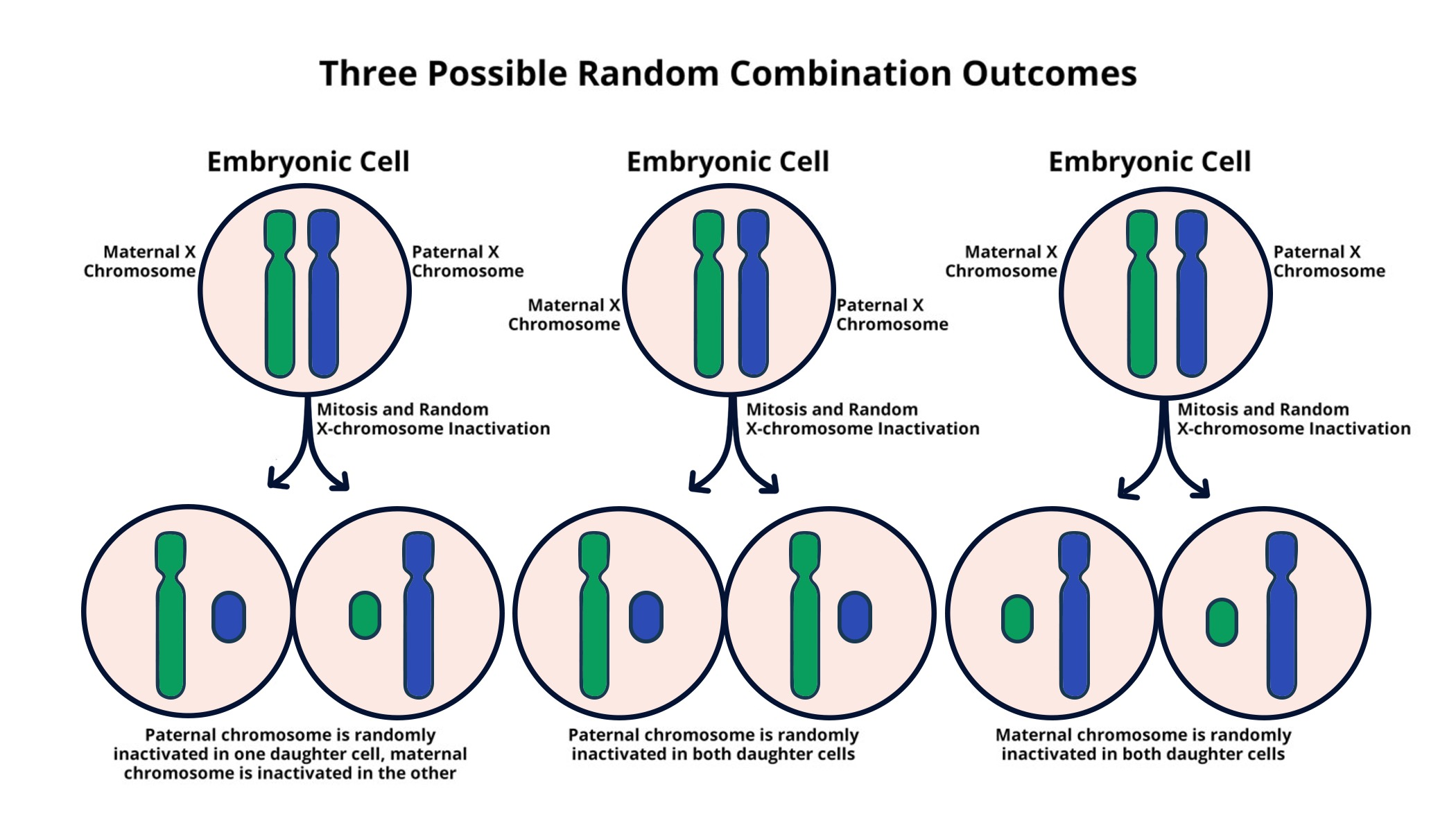
X-Chromosome Inactivation: A Breakthrough in Gene Therapy
X-chromosome inactivation is a fascinating and intricate process that plays a pivotal role in the genetic landscape of female mammals. This phenomenon ensures that females, who possess two X chromosomes, do not have a double dose of the genes located on these chromosomes, preventing potential imbalances. The understanding of X-chromosome inactivation has significant implications in the field of gene therapy, particularly for genetic disorders like Fragile X Syndrome and Rett Syndrome. Recent breakthroughs in chromosomal research have unveiled the mechanisms behind this silencing process, shedding light on how the X chromosome can be manipulated to treat these conditions. As researchers explore these pathways, the potential to develop effective therapies continues to expand, offering hope for those affected by X-linked genetic disorders.
The concept of X-chromosome silencing, sometimes referred to as X-inactivation, highlights the unique challenges posed by the chromosomal composition in female cells. Unlike their male counterparts, females need a mechanism to equalize gene expression from their two X chromosomes, which is achieved through this intricate silencing process. Research into this crucial genetic regulatory mechanism not only illuminates fundamental aspects of cell biology but also holds promise for innovative treatments for conditions such as Fragile X and Rett syndromes. By unlocking the secrets of X-inactivation, scientists aim to devise targeted gene therapies that could alleviate symptoms linked to these genetic disorders. As advancements in chromosomal biology continue to unfold, the prospect of novel interventions for patients becomes increasingly plausible.
Understanding X-Chromosome Inactivation
X-chromosome inactivation (XCI) is a crucial cellular mechanism that specifically affects female mammals. This process ensures that females, who have two X chromosomes, do not express twice the amount of genes linked to the X chromosome compared to males, who possess only one. This biological balance is vital in preventing the overexpression of X-linked genes, which can lead to various genetic disorders. Researchers have long pursued the underlying mechanisms of XCI, aiming to unravel how cells select which X chromosome to silence and the physiological implications of this choice.
Recent breakthroughs, particularly from the research conducted in Jeannie Lee’s lab, have shed light on how XCI occurs at a molecular level. By investigating the role of Xist RNA and its interaction with a gelatinous substance surrounding chromosomes, scientists have uncovered a complex dance between Xist and chromatin structure. This insight not only enhances our understanding of XCI but also opens doors to potential therapies for conditions like Fragile X Syndrome and Rett Syndrome, where mutations in X-linked genes lead to significant developmental challenges.
The Role of Chromosomal Research in Gene Therapy
Chromosomal research plays a pivotal role in the evolution of gene therapy, especially in the context of genetic disorders linked to the X chromosome. By deciphering the intricate processes governing X chromosome behavior, researchers can pinpoint the mutations responsible for conditions like Fragile X and Rett Syndromes. Understanding these mechanisms allows for the development of targeted gene therapies aimed at ‘unsilencing’ beneficial genes, potentially restoring lost functions in affected individuals.
The therapeutic approaches designed to manipulate X-linkage have already shown promise in preclinical models. By focusing on the molecular basis of XCI, researchers can devise strategies that may deactivate harmful genes while preserving the function of their healthy counterparts. This specificity is key in gene therapy, as it greatly minimizes the risk of adverse effects that typically accompany broader gene-editing techniques. The ongoing research in chromosomal behavior not only enhances our comprehension of genetic conditions but also paves the way for pioneering treatment options.
Advancements in Treatment for Fragile X and Rett Syndromes
Fragile X Syndrome and Rett Syndrome are two of the most significant X-linked genetic disorders impacting cognitive and physical development. Research led by Jeannie Lee has demonstrated that understanding the mechanics of X-chromosome inactivation can lead to innovative treatment avenues. By aiming to unsilence genes that remain inactive due to XCI, scientists are exploring therapeutic agents that could reactivate these dormant genes, providing new hope for individuals affected by these devastating conditions.
The ability to restore function to inactivated genes offers a promising pathway not only for females but also for males who possess mutations on their single X chromosome. As clinical trials approach, the potential of these treatments to significantly improve quality of life for patients with Fragile X Syndrome and Rett Syndrome is encouraging. By employing focused gene therapy strategies, researchers hope to target the root causes of these genetic disorders, potentially alleviating symptoms and enhancing developmental outcomes.
The Genetic Basis of X-linked Disorders
X-linked disorders such as Fragile X Syndrome and Rett Syndrome provide a compelling insight into how genetic factors contribute to disease susceptibility. These disorders are primarily caused by mutations on the X chromosome, which can lead to various neurological and developmental challenges. The investigation of these genetic underpinnings not only sheds light on the mechanisms that drive these conditions but also highlights the importance of XCI in regulating gene expression.
Understanding the genetic basis of these disorders is vital for the development of effective treatments. By investigating how genes associated with these syndromes become inactivated, researchers can develop targeted therapies that aim to counteract the effects of these mutations. The ongoing research in the field of genetic disorders related to the X chromosome is crucial for creating viable strategies that could significantly improve patient outcomes and pave the way for transformative gene therapy solutions.
Potential of Gene Therapy for X-linked Genetic Disorders
The potential of gene therapy as a treatment for X-linked genetic disorders is gaining traction, particularly with discoveries in X-chromosome inactivation research. By engineering therapies that can activate previously silenced genes within X-linked disorders, researchers envision a future where individuals suffering from conditions like Fragile X Syndrome and Rett Syndrome can experience meaningful recovery. The goal is to use targeted gene delivery systems that effectively reach the cells and reintroduce the functional version of genes that have been inactivated.
In recent studies, scientists have successfully demonstrated strategies for unsilencing dormant genes associated with X-linked disorders. This breakthrough offers hope not only for females affected by such genetic conditions but also for males who may carry detrimental mutations. As the research evolves, the possibility of developing comprehensive gene therapies that address the unique challenges posed by X-linked genetic disorders becomes increasingly feasible.
Impact of X-Chromosome Inactivation on Male Genetic Disorders
While X-chromosome inactivation primarily implicates female genetics due to their double X chromosomal architecture, the impacts on male genetic disorders should not be overlooked. For males, who possess only one X chromosome, the presence of mutations direct consequences for their health. The implications of XCI research extend to elucidating how similar silencing processes occur in X-linked genes in males, especially those with conditions such as Fragile X Syndrome.
This line of research provides essential insights that could lead to breakthroughs in treatment strategies not only for females but also for males wrestling with these genetic disorders. By understanding the mechanisms of gene silencing and activation, researchers could develop therapies that target and reactivate healthy gene functions, providing new hope for patients across genders affected by X-linked genetic disorders.
The Future of Chromosomal Research and Gene Therapy
The future of chromosomal research holds immense potential for advancing gene therapy techniques. As scientists continue to investigate the complexities of X-chromosome inactivation, there is optimism about developing innovative therapies that target specific genetic disorders such as Fragile X and Rett Syndromes. The knowledge gained from understanding how cells orchestrate chromosomal silencing can be harnessed to influence gene expression creatively, leading to groundbreaking treatment options.
These future therapies could transform the treatment landscape for genetic disorders, offering patients not just symptomatic relief but a potential pathway to long-term recovery. By focusing on the intricate interplay of genetic mechanisms, researchers aim to unlock the potential to treat a range of conditions comprehensively, paving the way for significant improvements in patient quality of life and overall health outcomes.
Understanding the Physical Properties of Chromosomes
The physical properties of chromosomes, particularly concerning the gelatinous material that surrounds them, play a crucial role in cell function and genetic expression. This ‘Jell-O-like’ substance facilitates the organization of chromosomes within the nucleus, preventing tangling and ensuring proper cellular activity. These properties are particularly relevant when discussing processes like X-chromosome inactivation, where alterations in the chromatin structure can lead to profound impacts on gene expression.
Recent insights into the mechanics of this chromosomal environment have opened new avenues for understanding potential treatments for genetic disorders. By manipulating the physical properties of the chromatin, scientists can explore ways to re-engage silenced genes, potentially reversing the effects of harmful mutations found in disorders linked to the X chromosome. Such transformative research continues to bridge the gap between basic scientific inquiry and therapeutic application.
The Intersection of Cell Biology and Genetics
Cell biology and genetics intersect significantly in the study of X chromosome inactivation and its implications for genetic disorders. The understanding of how genes are regulated at the chromosomal level helps to illuminate the pathways through which mutations manifest as disease. This discipline’s insights are crucial for pinpointing therapeutic windows where interventions can be most effective, particularly in conditions like Fragile X Syndrome and Rett Syndrome.
As researchers delve deeper into the connectivity between cell biology and genetic expression, it becomes increasingly clear that targeting molecular pathways involved in XCI can yield powerful therapeutic strategies. This combined approach may enable scientists to design therapies that focus not only on correcting genetic mutations but also on enhancing the body’s natural mechanisms to regulate gene function, offering hope for those affected by genetic disorders.
Frequently Asked Questions
What is X-chromosome inactivation and why is it important in genetic disorders?
X-chromosome inactivation is a biological process that occurs in female mammals, where one of the two X chromosomes is silenced to prevent an excess of gene products. This process is crucial in the context of genetic disorders, as many conditions, including Fragile X Syndrome and Rett Syndrome, are linked to mutations on the X chromosome. Understanding X-chromosome inactivation can pave the way for innovative gene therapy approaches to treat these genetic disorders.
How does X-chromosome inactivation relate to gene therapy for Fragile X Syndrome?
X-chromosome inactivation directly impacts gene therapy for Fragile X Syndrome because the condition is often caused by mutations on the X chromosome. By understanding how to manipulate or reverse X-inactivation, researchers aim to reactivate the healthy version of the gene that is silenced, potentially leading to effective treatments for affected individuals.
What role does the Xist RNA molecule play in X-chromosome inactivation?
The Xist RNA molecule is critical in the process of X-chromosome inactivation. It initiates the silencing of one X chromosome in females by coating the chromosome and altering the surrounding material’s properties, which leads to its inactivation. This mechanism is vital for maintaining gene dosage balance and has implications for treating genetic disorders like Fragile X and Rett Syndromes.
Can X-chromosome inactivation be reversed to treat genetic disorders?
Yes, recent research suggests that X-chromosome inactivation can potentially be reversed. This discovery opens up new avenues for treating genetic disorders caused by X-linked mutations, such as Fragile X Syndrome and Rett Syndrome, by allowing the expression of healthy genes that were previously silenced.
What is the significance of Jell-O-like substances in understanding X-chromosome inactivation?
The Jell-O-like substance refers to the gelatinous material that surrounds chromosomes, crucial for their proper organization and functioning. In the context of X-chromosome inactivation, this substance plays a key role in creating an environment where the Xist RNA can effectively silence one of the X chromosomes. This understanding can advance chromosomal research and lead to therapeutic strategies for X-linked genetic disorders.
What are the potential therapeutic implications of unsilencing the X chromosome in patients with genetic disorders?
Unsilencing the X chromosome holds significant therapeutic potential for patients with genetic disorders like Fragile X Syndrome and Rett Syndrome. By reactivating the healthy gene on the inactivated chromosome, it may restore normal function and alleviate symptoms associated with these conditions, leading to improved quality of life for affected individuals.
How does the process of X-inactivation differ in males compared to females?
In males, there is only one X chromosome, so X-inactivation does not occur. However, males can still experience gene silencing effects, such as in the case of certain mutations that may affect the functionality of the X chromosome. Understanding these differences is essential for developing targeted treatments in both females and males for X-linked genetic disorders like Fragile X and Rett Syndromes.
| Key Points |
|---|
| X-chromosome inactivation (XCI) is a process where one of the two X chromosomes in females is inactivated to prevent gene dosage imbalance between sexes. |
| Jeannie Lee’s lab has been pivotal in researching how XCI occurs, revealing its dependence on a gelatinous substance surrounding chromosomes, akin to Jell-O. |
| A gene on the X chromosome produces Xist RNA, which modifies the properties of the surrounding ‘Jell-O’, facilitating XCI. |
| The research shows potential for future treatments of genetic disorders like Fragile X Syndrome and Rett Syndrome by ‘unsilencing’ the inactivated X chromosome. |
| Understanding XCI could lead to cures with minimal side effects, as it appears to selectively restore function to mutated genes without affecting healthy ones. |
| After 25 years of research, the findings from Lee’s lab are now paving the way for potential clinical trials and therapeutic advancements. |
Summary
X-chromosome inactivation (XCI) is a critical biological process that ensures gene dosage balance in females by silencing one of the two X chromosomes. Recent breakthroughs from Jeannie Lee’s lab have shed light on the mechanisms behind XCI, showing its reliance on a gelatin-like substance that organizes chromosomes and facilitates the action of Xist RNA. The implications of this research are profound, as they suggest pathways toward treating genetic disorders associated with X-linked mutations, potentially benefiting both females and males. The journey from fundamental research to therapeutic application underscores the importance of understanding X-chromosome inactivation in advancing gene therapy and improving patient outcomes.


